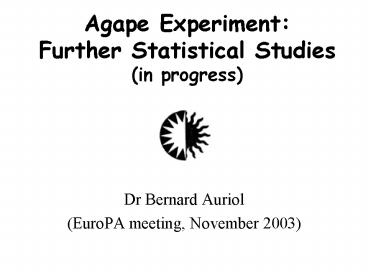Agape Experiment: Further Statistical Studies (in progress) - PowerPoint PPT Presentation
Title:
Agape Experiment: Further Statistical Studies (in progress)
Description:
Agape Experiment: Further Statistical Studies (in progress) Dr Bernard Auriol ... Agape Experiment lasted seven years to test H1 : ... – PowerPoint PPT presentation
Number of Views:34
Avg rating:3.0/5.0
Title: Agape Experiment: Further Statistical Studies (in progress)
1
Agape ExperimentFurther Statistical Studies(in
progress)
- Dr Bernard Auriol
- (EuroPA meeting, November 2003)
2
Protocol
Agape Experiment lasted seven years to test H1
The rate of hits could be increased by
redundancy due to vote. To test it, there were a
transmitting group (emission-strength of 1 to 16
senders) and a receiving group (1 to 16 voters),
located in two separate isolate rooms. Everything
was monitored and recorded thanks to several
computers and a network especially designed for
the experiment. Three main protocols were tested
with Two pictures , Three words, or Five words as
possible target. Moreover, different parameters
varied from one session to another in order to
find the best conditions for later replications.
3
targets type either pictures or words
possible answers number gt 2, 3 or 5
Participants any voluntary either sheep or
goat sender or receiver role generally chosen by
the participants 274 female (2/3) 145 male (1/3)
240 telepathic ESP group sessions, 27,845
collective trials 250,000 individual trials !
4
Individual Answers
5
Majority Vote
6
Variance of success got by vote(15 trials per
salvo)
7
Variance of success got by vote(30 trials per
salvo)
8
Variance of success got by vote(60 trials per
salvo)
9
Variance of intervals
- To reach a better evaluation, we note the
interval (? number of misses) - between two consecutive hits, and check the
variance of these intervals - (at random or not ?).
10
Variance of the intervals
11
Instable Attitudes of Receivers ?
That apparently inconsistent set of
variances shifting according to the
protocol could be linked to an alternation along
the sessions of Goal-Oriented Socio-psychological
Attitudes producing in turn Psi-Nothing,
Psi-Hitting and Psi-Missing.
12
Majority Strength and Success of Vote
If some answers are not due to chance but to ESP,
this should have an impact on the majority
Strong majorities could be more linked to
success than weak ones. Unlike what we
expected, strong majorities didnt get better
results than weak ones
13
Conclusionof the hypothesis test
The results did not fulfil our hope regarding a
possible improvement of the Signal to Noise ratio
(S/N) (redundancy got from majority
vote). This way of carrying out the
experiment, did not strongly increase the
Psi-Hitting rate as we expected, but seems to
have made the results random, regarding either
individual answers or answers obtained by vote.
14
Prospective purpose
- Covariance Analysis
15
Nevertheless, for heuristic purpose, we undertook
a covariance analysis on collective trials which
are significantly different from chance (p lt
0.05) In order to test the effect of each
variables modality, we used a transformation of
the percentage of hits to be able to compare
the results for the protocols with two pictures,
three or five words. where- is the
percentage of right answers in the trial p is
the expected percentage
16
We can test if the percentage of hits got for
each tria l is significantly lower than chance,
significantly higher than chance, or equal to
chance, thanks to a test of Khi2. The statistic
of this test, calculated for each trial, is
Khi2 (one df)
with po expected percent of successes
observed percent of successes
17
Collective trials significantly different from
chance (p lt0.05)
18
We focused on the trials where the percentage of
hits differed significantly from chance
expectation. The effect of different parameters
on the answers kept was outlined with a
covariance analysis. The significant
variables were selected thanks to a stepwise
procedure and kept under a threshold of 5. We
get significant parameters with a p-value close
to 0.0001
19
Collective trials significantly departing from
chance
Qualitative Variables
20
Collective trials significantly departing from
chance
Quantitative Variables
21
Effect of the relationship between participants
For the trials significantly higher than chance
expectation, adjusted R² equals 10.8 ( small
effect according to Cohens convention)
Familiarity between Receivers moves the results
closer to chance. Familiarity between Senders
and Receivers moves the results away from chance.
22
Conclusion
- Is Psi-Missing a cross-boarder defense system
- ?
If there was any Psi manifestation in our
experiment, there would be a strong tendency to
reject the right answer as an aggression coming
from the transmitters sub-group. Couldnt that
be the need for each individual to avoid his own
dissolution, especially if the individual
belongs to a group, (situation which favours the
fusion among the members) ?
23
Sybil
We plan to devise a protocol to test the
following hypothesis We can hope for success
with groups only if we build sub-groups so that
there is more affinity between receivers and
senders than among receivers. A simple
sociometric test should be enough to achieve
this, provided the results for each sessions
help to distribute the roles of transmitter and
receiver.































